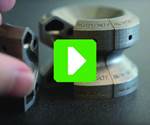Video: Metal AM Affects Plastics Production via Conformal Cooling
Additive manufacturing allows cooling channels within mold tooling inserts to follow the form of the tool rather than being straight drilled holes. Here’s why this matters.

Mold insert with conformal cooling channels that can be seen in the transparent model in the foreground.
Additive manufacturing (AM) allows cooling channels within mold tooling inserts to follow the form of the tool rather than being straight drilled holes. I filmed this video discussing conformally cooled mold inserts in the AM machine demo area of the U.S. headquarters for Matsuura:
Transcript
I’m at Matsuura. One of the most significant impacts of metal additive manufacturing is going to be on plastic part production. I’m referring to conformal cooling, the chance to use additive manufacturing to build conforming cooling channels into an injection mold component. More effective cooling potentially means seconds per part shaved from the injection molding cycle, the cycle making a plastic part. Seconds per part might not sound like much, but multiply that across millions of parts that might be made through injection molding, might be made using a tool like this, and the result could be production so much faster that fewer injection molding presses would be needed to achieve the same production in the same amount of time.
One other feature of this machine from Matsuura: It is a hybrid machine. In addition to building additively, it also mills as it goes, machining the part to completion within the same cycle. The result can be considerable lead time savings for the chance to make this component complete all in one cycle as opposed to different setups for machining, EDM, heat treating.
Related Content
-
8 Ways the Plastics Industry Is Using 3D Printing
Plastics processors are finding applications for 3D printing around the plant and across the supply chain. Here are 8 examples.
-
Daimler, OMIC Evaluate Wire-Fed DED for Moldmaking
3D printing a core and cavity on machine from Gefertec, followed by machining, allowed for a complete mold tool to be produced in three days.
-
Video: Hybrid Manufacturing Without Melting: Hermle’s Metal Powder Application (MPA) Process
The Metal Powder Application (MPA) process uses cold spray to apply metal to an existing workpiece. Because the material deforms rather than melts, MPA opens new possibilities for functional grading and other multimaterial applications.











